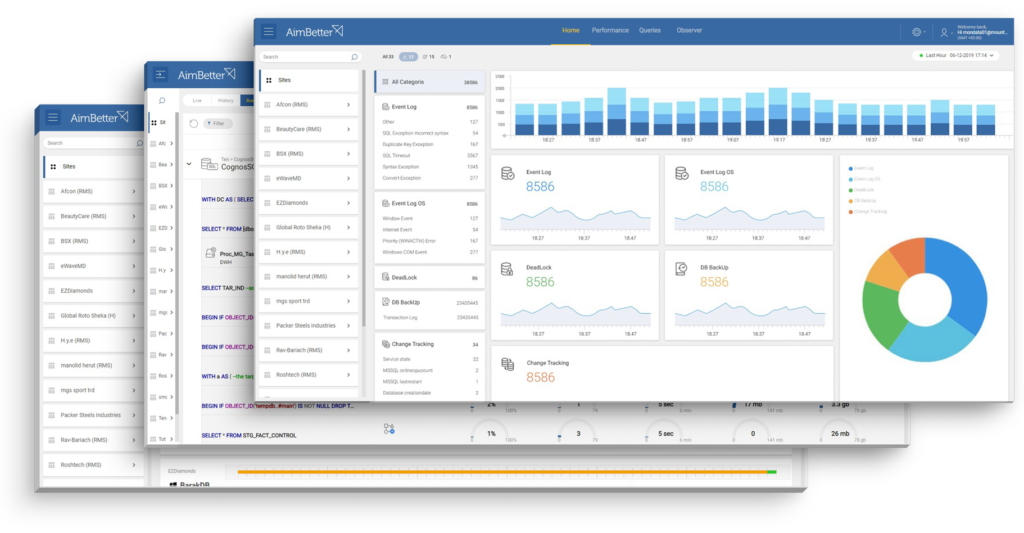AimBetter, the Israeli development that is revolutionizing the world of monitoring and automatic handling of malfunctions, helps reduce expenses and increase the profit line of hundreds of organizations around the world. And all without human intervention.
An Interview with Yehuda Lasri, AimBetter’s CEO and Co-founder
 The current economic climate is characterized by uncertainty and instability. Inflation in the US has soared to a decades-long high, companies have a harder time raising funds, the market is volatile, and signs of a slowdown or recession are increasing. In such a reality, organizational survival and the ability to maintain a high level of profitability pass through streamlining the various organizational systems. In an era where organizations increasingly rely on digital infrastructure, applications, and information systems, quick identification and troubleshooting will make a difference worth millions of dollars in the organizational profit line.
The current economic climate is characterized by uncertainty and instability. Inflation in the US has soared to a decades-long high, companies have a harder time raising funds, the market is volatile, and signs of a slowdown or recession are increasing. In such a reality, organizational survival and the ability to maintain a high level of profitability pass through streamlining the various organizational systems. In an era where organizations increasingly rely on digital infrastructure, applications, and information systems, quick identification and troubleshooting will make a difference worth millions of dollars in the organizational profit line.
For example, a Gartner report back in 2014 found that downtime to enterprise IT systems causes $5,600 per minute of damages. According to data published by Ponemon Institute in 2016, the damages increased to $9,000 every minute, and recent data speaks of even higher damages. But even if you spend “only” $9,000 per minute, it can lead to total damage of more than half a million dollars per downtime. This is a widespread phenomenon that affects many organizations: according to a survey conducted in 2022 by Business Wire, 1 in 5 companies has suffered during the past 3 years from malfunctions that led to the shutdown. Added to the damage caused by malfunctions, errors and slow problems in corporate computer systems.
“The good news is that the faults and the return that are causing enormous economic damage to the organization is not a decree of fate,” says Yehuda Lasri, CEO and co-founder of AimBetter. The Israeli company has developed an automated platform for real-time analysis and control of databases and enterprise applications. In doing so, it enables hundreds of companies and corporations to lead to a significant reduction in error and malfunction handling time without human intervention.
 What are the causes of the growing damages of computer problems?
What are the causes of the growing damages of computer problems?
“The organization’s reliance on computer and data systems is growing, as is the complexity of these systems and the people needed to maintain it. When a malfunction occurs, we turn to the integrators who implemented the system, the IT person within the organization, and the DBA.
The problem starts when they have difficulty seeing the full picture: none of them know what happened in real time inside and outside the server and the virtual systems. As a result, the solution of the problem is getting longer and longer, weighing on employees and customers and expanding the damage to the financials. In some cases, they simply fail to open the problem, which causes internal and external customers to work with a system that works in a ‘crooked’ and ineffective manner.”
How do errors and malfunctions harm organizations that contact you?
“The most painful point for the organizations we meet is the damage to the bottom line. I call this the ‘disappearing invoice syndrome’: decision-makers in organizations are aware of the damage to the profit line but are not always aware of its scope and intensity. No one really quantifies the total damage, including paying vendors, working time of system personnel, and IT within the organization. No one quantifies the loss of productivity and the negative impact on sales either. That’s how it is when the word ‘maintenance’ hides uncommitted expenses and diverts organizational resources from focusing on business goals to addressing malfunctions. In this way, the damage to the profit line can reach hundreds of thousands and even millions of dollars.
It is not only the financial damage that harms the organization: the problems and malfunctions also lead to image damage and the erosion of human capital. When a senior IT person at a large retail chain tells me that even on the weekends, he can’t rest because of malfunctions that happen around the clock, I ask myself how long he’ll last in this position.”
Can you give an example from the field?
“I’ll give you a fresh example. Not long ago, we were approached by the managers of a large hospital in Israel, which for six months struggled to locate the source of the problem of a malfunction in the SAP system of the network of dental clinics it operates: users of the system suffer from slowness, disconnections and perhaps most serious of all: from the loss of information entered.
As far as the integrator who was responsible for implementing the system in the organization, he works with other customers who do not suffer from malfunctions – so for him, the problem is in the organizational systems; The hospital’s DBA does not know how to locate the source of the problem, as long as the system is running, and the server resources are normal. As far as the System man is concerned, there is no communication problem. But the bottom line is that the users continued to suffer until the hospital came to us. Within 10 minutes of installing the AimBetter solution – the problem was detected, and a detailed report was produced with all the faults. Everything is automated and fast.”
How did you lead within 10 minutes to solve a problem that had plagued the organization for six months?
“AimBetter’s system is based on a self-service solution that identifies in real-time loads anomalies in the database array and also, of course, identifies problems and the causes of their formation.
 Everything is fully automated. Along with the ability to detect problems, the system performs real-time monitoring and helps to take proactive actions to prevent systems from malfunctioning or failing. This is achieved through unified and centralized supervision of all database components – Database Performance Monitoring.
Everything is fully automated. Along with the ability to detect problems, the system performs real-time monitoring and helps to take proactive actions to prevent systems from malfunctioning or failing. This is achieved through unified and centralized supervision of all database components – Database Performance Monitoring.
The advantages of the system help hundreds of companies such as BDO, H&M, Brinks, Monday and more to streamline the day-to-day operations, minimize the chances of malfunctions and dramatically reduce the handling time when they already occur.”
What is the added value of the system in relation to human troubleshooting?
“I will answer you from my personal story. I started developing the system about ten years ago due to a personal need: At the time, the company I founded provided DBA services to a variety of leading companies. Over time, I wanted to expand, and I understood the complexity of recruitment, training, and staff turnover. This insight led to the development of an automated solution designed to cut off the organizations I serve from the human factor. And so, over the years, the AimBetter solution was born. The advantage of the platform is not only in the ability to automatically perform rapid monitoring and detection operations, but in its holistic capabilities. The system combines the capabilities of DBA people, IT professionals and application personnel to produce a broad picture, which leads to quick detection of the fault causes and helps to solve it as soon as possible.
 The automation of the work of monitoring and detecting faults saves valuable work time for the organization’s employees and, moreover: eliminates the need to hold in-house functionaries such as DBA. As a result, many of the organizations that use the AimBetter solution, such as software companies, have increased their customer base by hundreds of percent, almost without adding IT teams.”
The automation of the work of monitoring and detecting faults saves valuable work time for the organization’s employees and, moreover: eliminates the need to hold in-house functionaries such as DBA. As a result, many of the organizations that use the AimBetter solution, such as software companies, have increased their customer base by hundreds of percent, almost without adding IT teams.”
And if you still need human intervention?
“AimBetter’s solution is offered in a cloud service (SaaS) model that allows the company to monitor, detect, and resolve issues on its own. At the same time, we offer expert support services from DBA experts, who provide professional support in solving problems that the system recognizes.”
How does your solution help companies increase their bottom line?
“The need for a quick solution of the detected malfunctions and the prevention of the formation of malfunctions in the first place leads to significant financial savings. This is partly due to the savings in many working hours and the cost to the various suppliers. The saving of time and resources enables those involved to shift the focus from extinguishing fires to focusing on the core activity, striving towards the goals and locating growth engines. The ability to handle malfunctions quickly also reduces the percentage of abandonment in sales processes, helps to increase sales, and in manufacturing companies, it also increases productivity. All these contribute to reducing expenses and increasing the profit line in organizations that we service by hundreds of thousands and sometimes even millions of dollars.
Reducing the margin for errors and malfunctions also contributes to reducing burnout among many employees who have to deal with multiple malfunctions and inquiries. In addition, just like in my personal story that led to the development of the AimBetter solution, organizations that use our solution also reduce their dependence on human capital: you don’t have to spend years training employees who will be familiar with the various systems, and experience an earthquake when they leave due to the need to recruit replacements and go through a long training process.
The AimBetter platform significantly flattens the learning curve, allowing any organization to monitor, prevent, and address issues quickly – with all the benefits that come with it. And all at accessibility costs, for SMB and for companies of all sizes.”











